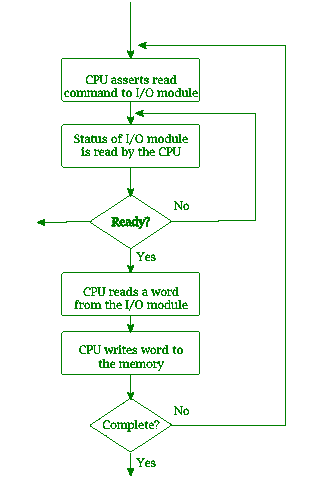| (a) |
In DMA,what is cycle stealing? Cycle stealing is a strategy whereby the DMA module uses the system bus to move data between the I/O module/external device at times when the CPU is not using the bus (1). The DMA module transfers one word and returns control to the CPU (1).
|
[2] |
| (b) |
Describe programmed I/O using a flowchart.
(2)for the correct general sequence;(2)for the correct decisions (diamonds)and corresponding loops;(2)for the details.
|
[6] |
| (c) |
Explain the main differences between interrupt-driven I/O and the programmed I/O you have described. In programmed I/O,the CPU is placed in a tight loop waiting for the I/O module to become ready (1).vIn interrupt-driven I/O,the CPU continues with other work until it is interrupted by the I/O module becoming ready and wanting to do a transfer (1).
|
[2] |
| (d) |
What is the significant advantage of interrupt-driven I/O over programmed I/O? The fact that the CPU can do other work whilst it is waiting for the I/O device to become ready.
|
[1] |
| (e) |
For the following situations,saywhich I/O techniques would be most appropriate,and explain why. (i)A processor responsible for updating a remote digital clock display. A processor responsible for updating a remote digital clock display. Interrupt-driven (1)in the sense that other features can be activated such as an alarm during the normal operation (1) (ii)A processor responsible for updating an aircraft cockpit instrumentation panel. DMA (1):because transfer rate is important and the processor will typically need to attend to other work whilst I/O is proceeding. The transfer of vital data is important and it requires a fast and efficient method (1). |
[4] |
